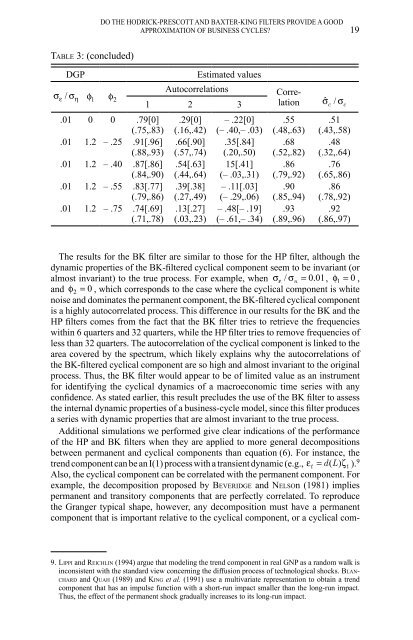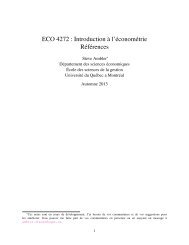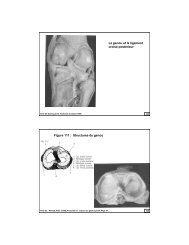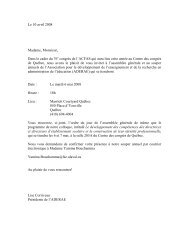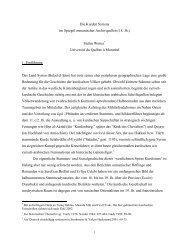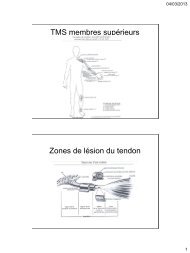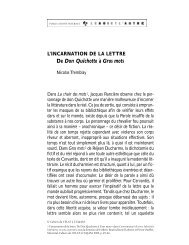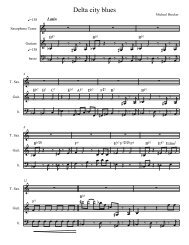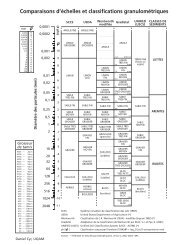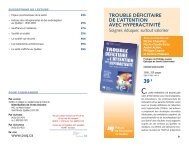Do the Hodrick-Prescott and Baxter-King Filters Provide a ... - UQAM
Do the Hodrick-Prescott and Baxter-King Filters Provide a ... - UQAM
Do the Hodrick-Prescott and Baxter-King Filters Provide a ... - UQAM
You also want an ePaper? Increase the reach of your titles
YUMPU automatically turns print PDFs into web optimized ePapers that Google loves.
DO THE HODRICK-PRESCOTT AND BAXTER-KING FILTERS PROVIDE A GOOD<br />
APPROXIMATION OF BUSINESS CYCLES? 19<br />
TABLE 3: (concluded)<br />
DGP<br />
σε<br />
/ ση<br />
1<br />
φ φ2<br />
.01 0 0 .79[0]<br />
(.75,.83)<br />
.01 1.2 – .25 .91[.96]<br />
(.88,.93)<br />
.01 1.2 – .40 .87[.86]<br />
(.84,.90)<br />
.01 1.2 – .55 .83[.77]<br />
(.79,.86)<br />
.01 1.2 – .75 .74[.69]<br />
(.71,.78)<br />
Autocorrelations<br />
Estimated values<br />
1 2 3<br />
.29[0]<br />
(.16,.42)<br />
.66[.90]<br />
(.57,.74)<br />
.54[.63]<br />
(.44,.64)<br />
.39[.38]<br />
(.27,.49)<br />
.13[.27]<br />
(.03,.23)<br />
– .22[0]<br />
(– .40,– .03)<br />
.35[.84]<br />
(.20,.50)<br />
15[.41]<br />
(– .03,.31)<br />
– .11[.03]<br />
(– .29,.06)<br />
– .48[– .19]<br />
(– .61,– .34)<br />
Correlation<br />
σˆ / σ<br />
.55<br />
(.48,.63)<br />
.68<br />
(.52,.82)<br />
.86<br />
(.79,.92)<br />
.90<br />
(.85,.94)<br />
.93<br />
(.89,.96)<br />
c<br />
c<br />
.51<br />
(.43,.58)<br />
.48<br />
(.32,.64)<br />
.76<br />
(.65,.86)<br />
.86<br />
(.78,.92)<br />
.92<br />
(.86,.97)<br />
The results for <strong>the</strong> BK filter are similar to those for <strong>the</strong> HP filter, although <strong>the</strong><br />
dynamic properties of <strong>the</strong> BK-filtered cyclical component seem to be invariant (or<br />
almost invariant) to <strong>the</strong> true process. For example, when σε<br />
/ σ u = 0.01, φ 1 = 0 ,<br />
<strong>and</strong> φ 2 = 0 , which corresponds to <strong>the</strong> case where <strong>the</strong> cyclical component is white<br />
noise <strong>and</strong> dominates <strong>the</strong> permanent component, <strong>the</strong> BK-filtered cyclical component<br />
is a highly autocorrelated process. This difference in our results for <strong>the</strong> BK <strong>and</strong> <strong>the</strong><br />
HP filters comes from <strong>the</strong> fact that <strong>the</strong> BK filter tries to retrieve <strong>the</strong> frequencies<br />
within 6 quarters <strong>and</strong> 32 quarters, while <strong>the</strong> HP filter tries to remove frequencies of<br />
less than 32 quarters. The autocorrelation of <strong>the</strong> cyclical component is linked to <strong>the</strong><br />
area covered by <strong>the</strong> spectrum, which likely explains why <strong>the</strong> autocorrelations of<br />
<strong>the</strong> BK-filtered cyclical component are so high <strong>and</strong> almost invariant to <strong>the</strong> original<br />
process. Thus, <strong>the</strong> BK filter would appear to be of limited value as an instrument<br />
for identifying <strong>the</strong> cyclical dynamics of a macroeconomic time series with any<br />
confidence. As stated earlier, this result precludes <strong>the</strong> use of <strong>the</strong> BK filter to assess<br />
<strong>the</strong> internal dynamic properties of a business-cycle model, since this filter produces<br />
a series with dynamic properties that are almost invariant to <strong>the</strong> true process.<br />
Additional simulations we performed give clear indications of <strong>the</strong> performance<br />
of <strong>the</strong> HP <strong>and</strong> BK filters when <strong>the</strong>y are applied to more general decompositions<br />
between permanent <strong>and</strong> cyclical components than equation (6). For instance, <strong>the</strong><br />
trend component can be an I(1) process with a transient dynamic (e.g., ε t = d( L)<br />
ζ t ). 9<br />
Also, <strong>the</strong> cyclical component can be correlated with <strong>the</strong> permanent component. For<br />
example, <strong>the</strong> decomposition proposed by BEVERIDGE <strong>and</strong> NELSOn (1981) implies<br />
permanent <strong>and</strong> transitory components that are perfectly correlated. To reproduce<br />
<strong>the</strong> Granger typical shape, however, any decomposition must have a permanent<br />
component that is important relative to <strong>the</strong> cyclical component, or a cyclical com-<br />
9. LIPPI <strong>and</strong> REICHLIN (1994) argue that modeling <strong>the</strong> trend component in real GNP as a r<strong>and</strong>om walk is<br />
inconsistent with <strong>the</strong> st<strong>and</strong>ard view concerning <strong>the</strong> diffusion process of technological shocks. BLAN-<br />
CHARD <strong>and</strong> QUAH (1989) <strong>and</strong> KING et al. (1991) use a multivariate representation to obtain a trend<br />
component that has an impulse function with a short-run impact smaller than <strong>the</strong> long-run impact.<br />
Thus, <strong>the</strong> effect of <strong>the</strong> permanent shock gradually increases to its long-run impact.


